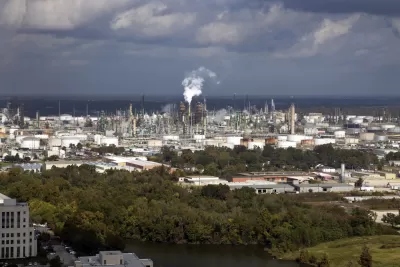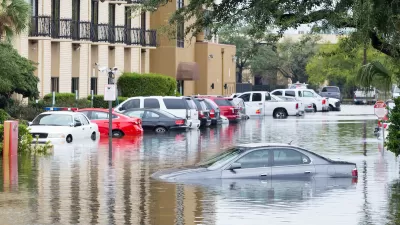Louisiana's chemical plants could release tons of toxic pollution into the air and water during storms, but anti-terrorism provisions make the process of finding risk management information prohibitively difficult.

A new analysis by New Orleans Public Radio (WWNO) and Southerly reveals high levels of risk for Louisiana communities located near the state's coastal chemical plants. The facilities, located in the path of annual hurricanes, emit more air pollution when they shut down in preparation for storms. If damaged by high wind or flooding, the plants run the risk of catastrophic pollution events that can expose wide swaths of the local community to toxic chemicals. The study used EPA data to identify the 30 facilities in the state that store the most toxic materials on site and analyzed the worst-case scenario for each. In ten cases, toxic gases could travel as far as 25 miles from the incident.
Information regarding risk management isn't always easy to come by in the post-9/11 era, with the chemical industry citing the potential for terrorist attacks as a reason to keep their plans closely guarded. To view industry risk management plans, residents have to make an appointment, view plans in person, and only take hand-written notes in the presence of a U.S. Marshal. A spokesperson for Shell, which owns four of the thirty plants in the analysis, would not discuss details but wrote in an email to WWNO that safety is a "top priority," adding that their operations follow strict federal, state, and local regulations.
But the secrecy can have an impact on local communities who can't easily assess the risks to their residents and first responders who lack the information to prepare for emergency scenarios. Emma Cheuse, an attorney with Earthjustice, calls the lack of information a "ticking time bomb" for coastal towns. Earthjustice is suing the EPA for rolling back Obama-era regulatory improvements and pushing for increased transparency and access to risk management information that can protect communities and help them prepare for future disasters.
FULL STORY: 'Ticking Time Bombs': Residents Kept In The Dark About Risks To La.'s Chemical Plants During Storms

Alabama: Trump Terminates Settlements for Black Communities Harmed By Raw Sewage
Trump deemed the landmark civil rights agreement “illegal DEI and environmental justice policy.”

Planetizen Federal Action Tracker
A weekly monitor of how Trump’s orders and actions are impacting planners and planning in America.

The 120 Year Old Tiny Home Villages That Sheltered San Francisco’s Earthquake Refugees
More than a century ago, San Francisco mobilized to house thousands of residents displaced by the 1906 earthquake. Could their strategy offer a model for the present?

Ken Jennings Launches Transit Web Series
The Jeopardy champ wants you to ride public transit.

BLM To Rescind Public Lands Rule
The change will downgrade conservation, once again putting federal land at risk for mining and other extractive uses.

Indy Neighborhood Group Builds Temporary Multi-Use Path
Community members, aided in part by funding from the city, repurposed a vehicle lane to create a protected bike and pedestrian path for the summer season.
Urban Design for Planners 1: Software Tools
This six-course series explores essential urban design concepts using open source software and equips planners with the tools they need to participate fully in the urban design process.
Planning for Universal Design
Learn the tools for implementing Universal Design in planning regulations.
Clanton & Associates, Inc.
Jessamine County Fiscal Court
Institute for Housing and Urban Development Studies (IHS)
City of Grandview
Harvard GSD Executive Education
Toledo-Lucas County Plan Commissions
Salt Lake City
NYU Wagner Graduate School of Public Service





























